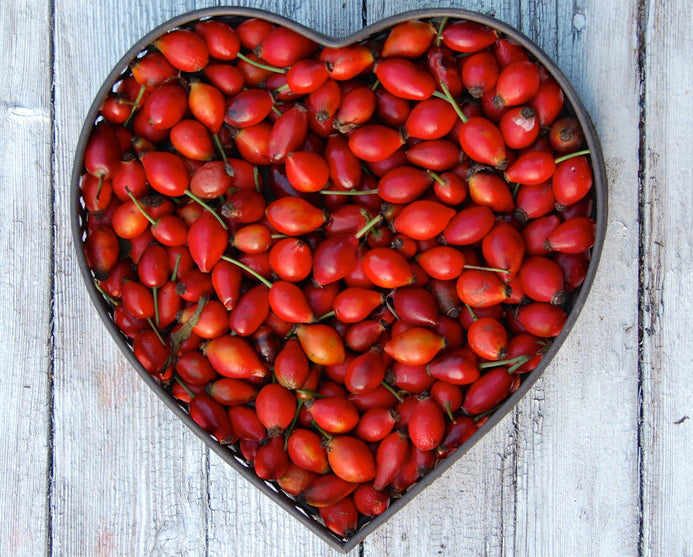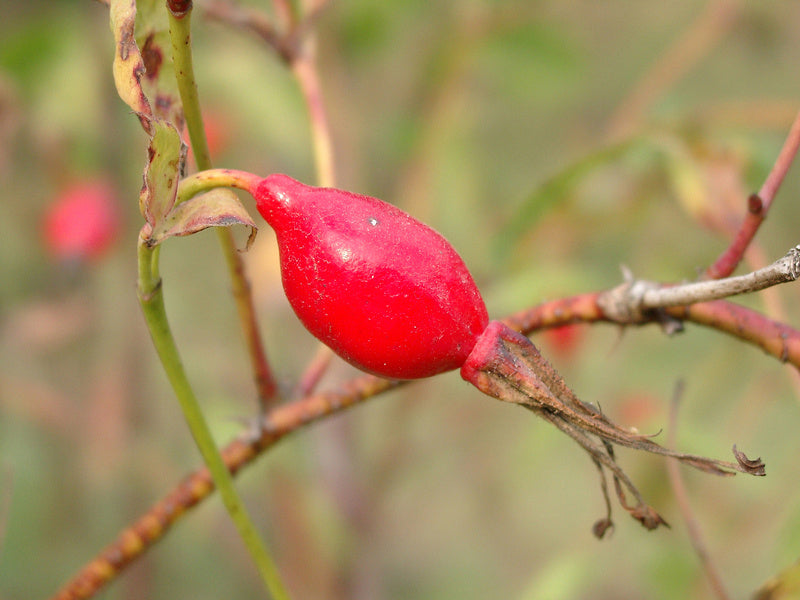rose hips
Red, red, red are all their colors! Roses are now adorned with red gems, creating pure delight. Discover the variety of rose hips—and your favorites for your own garden.



Puzzles about the little man and the red coat
Pot-bellied, round, narrow and oval, smooth and glossy, or bristly hairy – no two rose hips are alike. But they (almost) all bear the famous "purple coat" that is the subject of the well-known children's song by Hoffmann von Fallersleben. Tell me, who might that little man be...? Most people think of the enigmatic text as a fly agaric being sung about; in fact, the "black cap" appears in the second verse, and that is a clear reference to the rose hip – this refers to the dried-up flower calyx.
Bring on the red fruits
September and October are peak season for the plump red fruits. They're impossible to miss on walks through nature, in parks and gardens. Entire wild rose hedges covered in rose hips, sprawling shrub roses, laden with fruit. But not every rose bush dresses up so beautifully. If you've diligently pinched off wilted blossoms all summer, you'll wait in vain, as will densely filled rose varieties. Their stamens have been bred to form additional petals, so the flowers are sterile and don't produce fruit. Roses with single or semi-double flowers are the most reliable to produce fruit. But not all of them! Therefore, it's advisable to ask at the nursery when shopping; some growers also provide information about this in their catalogs.
Rosehip variety – one more beautiful than the other
Botanically speaking, rose hips are so-called aggregate fruits. The red husk develops from the receptacle after fertilization and encloses many small, hairy nuts, the seeds. Who doesn't remember them from childhood as itching powder? However, it's not the seeds that cause the itching, but the many small, barbed hairs that cling to the skin.
Rosa canina: Almost everyone knows it – our native dog rose. From June to July, it bears abundant, simple white-pink blossoms with a light but wonderful fragrance. Once this splendor is over, bright scarlet rose hips appear starting in September. Rose hips can be enjoyed for months from August to December. They are edible, contain plenty of vitamin C, and are perfect for making jam, jelly, juice, or liqueur.
Rosa rugosa:It is known as the apple rose or potato rose and is considered a very healthy and hardy wild rose that can cope with all soil conditions. It is known as a typical wild rose hedge on embankments, stone walls, or as property boundaries. The mostly pink or pure white flowers appear from June onwards and exude a lovely wild rose fragrance. The wonderful fragrance is not dependent on the color. The first rose hips form as early as July and later turn bright orange-red. They are fleshy and rich in vitamin C. The fruit adorns the plants for a long time.
Rosa multiflora:A fabulous bee pasture. As the name "multi-flowered rose" or "multi-flowered rose" suggests, this wild rose bears numerous small, white, strongly honey-scented blossoms and produces masses of miniature rose hips. A few branches make excellent vase decorations.
Rosa moyesii:With its bottle-shaped rose hips, the Mandarin rose, native to the mountains of western China, quickly wins fans. It is one of the most beautiful wild varieties available. This is also due to the blood-red color of its simple, medium-sized flowers, with their sunny-yellow stamens providing a striking contrast. In autumn, the orange-red, bottle-shaped rose hips provide a worthy representation of the flowers.
Rosa helenae syn. Pink floribunda:Its simple flowers are white, small, and fragrant. It blooms profusely in June and July in flat, umbel-shaped panicles. Rosa helenae is a wildly romantic rosehip rambler whose fruits are red, egg-shaped, and very numerous.
Rosa sweginzowii 'Macrocarpa':Its name, 'Macrocarpa', means "large-fruited" and already reveals the outstanding characteristic of this rose: Its bottle-shaped, glossy rose hips grow up to 5 cm in size and glow a vibrant orange-red in autumn. In summer, the plant bears simple, medium-sized, sweetly scented pink flowers on branches that it spreads like eagle wings.
Rosa rubiginosa:The wine rose, also known as the hedge rose, apple rose, or sweet briar, is a native wild rose species. Its foliage smells of ripe apples, especially in damp weather. The wine rose forms a very dense and heavily fortified shrub or entire impenetrable hedges, which is why it has become famous as the 'Scottish hedge rose'. Nothing can easily get through them. Its simple, small, delicate pink flowers appear in June, later transforming into abundant scarlet fruit. Its rose hips are often processed into wild rose oil and jam.

Vitamin-rich snacks for everyone
Few wild rose species retain their fruits as long as the dog rose, delighting us even in the dead of winter, amidst snow and ice. Rose hips are a delicacy for hungry birds. Native wild roses, in particular, are the perfect autumn and winter food for nearly 30 bird and nearly 20 mammal species. In addition to finches, thrushes, and siskins, other garden inhabitants such as the beech marten also enjoy the sweet and sour, vitamin-rich rose hips. They contain around five grams of vitamin C per kilogram, along with vitamins A, B1, and B2, as well as various fruit acids and pectin.
But there's still enough left to harvest plenty of rosehips from the wild or your own garden and make your own jam or liqueur. Basically, all rosehips are edible. The larger and fleshier the fruits, the easier they are to process. Sunny October days are the best harvest days. Most of the fruits are then almost fully ripe, are particularly sweet, and rich in vitamin C.
Rosehip liqueur
This is what you need:
500 g rosehips
150 g brown rock sugar
700 ml rum or double grain schnapps
And here's how it works:
Fill a liter bottle three-quarters full with cleaned rosehips. Then pour in grain schnapps or rum and place the bottle in a sunny spot for six weeks. Shake occasionally. Then filter the contents and pour into a new bottle with rock sugar. Let it steep for another 14 days. Refrigerate! Then pour into pretty little bottles.












































































































